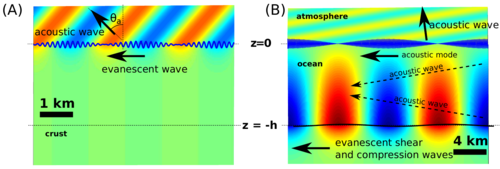Theory
Isolated traveling ocean surface gravity waves radiate only evanescent acoustic waves, [7] and don't generate microbaroms. [15]
The interaction of two trains of surface waves of different frequencies and directions generates wave groups. For waves propagating almost in the same direction, this gives the usual sets of waves that travel at the group speed, which is slower than phase speed of water waves. For typical ocean waves with a period around 10 seconds, this group speed is close to 10 m/s.
In the case of opposite propagation direction the groups travel at a much larger speed, which is now 2π(f1 + f2)/(k1 − k2) with k1 and k2 the wave numbers of the interacting water waves. For wave trains with a very small difference in frequency (and thus wave numbers), this pattern of wave groups may have the same horizontal velocity as acoustic waves, more than 300 m/s, and will excite microbaroms.

As far as seismic and acoustic waves are concerned, the motion of ocean waves in deep water is, to the leading order, equivalent to a pressure applied at the sea surface. [16] This pressure is nearly equal to the water density times the wave orbital velocity squared. Because of this square, it is not the amplitude of the individual wave trains that matter (red and black lines in the figures) but the amplitude of the sum, the wave groups (blue line in figures). The ocean motion generated by this "equivalent pressure" is then transmitted to the atmosphere.
If the wave groups travel faster than the sound speed, microbaroms are generated, with propagation directions closer to the vertical for the faster wave groups.

Real ocean waves are composed of an infinite number of wave trains of all directions and frequencies, giving a broad range of acoustic waves. In practice, the transmission from the ocean to the atmosphere is strongest for angles around 0.5 degrees from the horizontal. For near-vertical propagation, the water depth may play an amplifying role as it does for microseisms.

The water depth is only important for those acoustic waves that have a propagation direction within 12° of the vertical at the sea surface [17]
There is always some energy propagating in the opposite direction. However, their energy may be extremely low. Significant microbarom generation only occurs when there is significant energy at the same frequency and in opposing directions. This is strongest when waves from different storms interact or in the lee of a storm [18] [19] which produce the required standing wave conditions, [15] also known as the clapotis. [20] When the ocean storm is a tropical cyclone, the microbaroms are not produced near the eye wall where wind speeds are greatest, but originate from the trailing edge of the storm where the storm generated waves interact with the ambient ocean swells. [21]
Microbaroms may also be produced by standing waves created between two storms, [18] or when an ocean swell is reflected at the shore. Waves with approximately 10-second periods are abundant in the open oceans, and correspond to the observed 0.2 Hz infrasonic spectral peak of microbaroms, because microbaroms exhibit frequencies twice that of the individual ocean waves. [18] Studies have shown that the coupling produces propagating atmospheric waves only when non-linear terms are considered. [9]
Microbaroms are a form of persistent low-level atmospheric infrasound, [22] generally between 0.1 and 0.5 Hz, that may be detected as coherent energy bursts or as a continuous oscillation. [11] When the plane wave arrivals from a microbarom source are analyzed from a phased array of closely spaced microbarographs, the source azimuth is found to point toward the low-pressure center of the originating storm. [23] When the waves are received at multiple distant sites from the same source, triangulation can confirm the source is near the center of an ocean storm. [4]
Microbaroms that propagate up to the lower thermosphere may be carried in an atmospheric waveguide, [24] refracted back toward the surface from below 120 km and above 150 km altitudes, [18] [25] or dissipated at altitudes between 110 and 140 km. [26] They may also be trapped near the surface in the lower troposphere by planetary boundary layer effects and surface winds, or they may be ducted in the stratosphere by upper-level winds and returned to the surface through refraction, diffraction or scattering. [27] These tropospheric and stratospheric ducts are only generated along the dominant wind directions, [25] may vary by time of day and season, [27] and will not return the sound rays to the ground when the upper winds are light. [18]
The angle of incidence of the microbarom ray determines which of these propagation modes it experiences. Rays directed vertically toward the zenith are dissipated in the thermosphere, and are a significant source of heating in that layer of the upper atmosphere. [26] At mid latitudes in typical summer conditions, rays between approximately 30 and 60 degrees from the vertical are reflected from altitudes above 125 km where the return signals are strongly attenuated first. [28] Rays launched at shallower angles may be reflected from the upper stratosphere at approximately 45 km above the surface in mid-latitudes, [28] or from 60 to 70 km in low latitudes. [18]